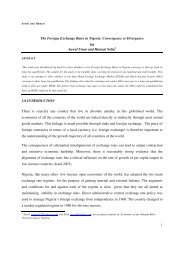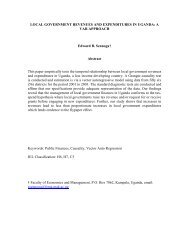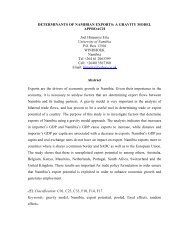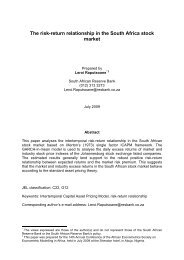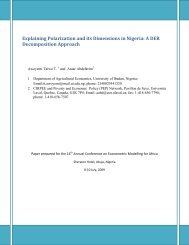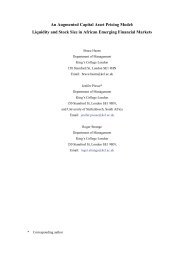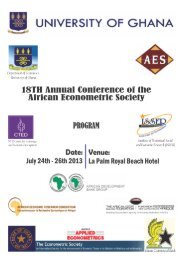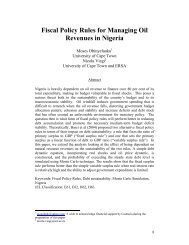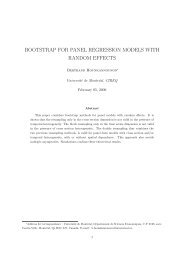Dynamic Effects of Monetary Policy Shocks in Malawi* - African ...
Dynamic Effects of Monetary Policy Shocks in Malawi* - African ...
Dynamic Effects of Monetary Policy Shocks in Malawi* - African ...
You also want an ePaper? Increase the reach of your titles
YUMPU automatically turns print PDFs into web optimized ePapers that Google loves.
(Quantitative Micro S<strong>of</strong>tware, LLC, 2005). Seasonal adjustment removes cyclical seasonalmovements that are common <strong>in</strong> time series observed at quarterly and monthly frequency. Theunderly<strong>in</strong>g trend component <strong>of</strong> the series, however, is reta<strong>in</strong>ed after the data has been seasonallyadjusted.The variables are further subjected to a test for stationarity, which reveals that they are all I(1)(See Table B1 <strong>in</strong> Appendix B). The study, however, proceeds with estimation <strong>of</strong> the SVAR <strong>in</strong>levels consistent with standard practice anchored on the canonical paper <strong>of</strong> Sims, Stock andWatson (1990). The Sims, Stock and Watson paper demonstrates <strong>in</strong> part that the commonpractice <strong>of</strong> attempt<strong>in</strong>g to transform models to stationary form by difference or co<strong>in</strong>tegrationoperators whenever it appears likely that the data are <strong>in</strong>tegrated is unnecessary because statistics<strong>of</strong> <strong>in</strong>terest <strong>of</strong>ten have distributions that are unaffected by nonstationarity, which suggests thathypotheses can be tested without first transform<strong>in</strong>g to stationary regressors. The issue, accord<strong>in</strong>gto the study, is not whether the data are <strong>in</strong>tegrated, but rather whether the estimated coefficientsor test statistics <strong>of</strong> <strong>in</strong>terest have a distribution which is nonstandard if <strong>in</strong> fact the regressors are<strong>in</strong>tegrated.The Sims, Stock and Watson (1990) f<strong>in</strong>d<strong>in</strong>gs have been generally accepted and widely adopted<strong>in</strong> the structural VAR literature. In a study <strong>of</strong> the German Bundesbank, Bernanke and Mihov(1997, p. 1037) ma<strong>in</strong>ta<strong>in</strong> that „we <strong>in</strong>clude the output, price, and reserves measures <strong>in</strong> levelsdespite their nonstationarity, as has become standard practice <strong>in</strong> VAR studies.‟ They furtherpo<strong>in</strong>t out that the levels specification yields consistent estimates whether co<strong>in</strong>tegration exists ornot, whereas a differences specification is <strong>in</strong>consistent if some variables are co<strong>in</strong>tegrated. Thepreference <strong>of</strong> VARs <strong>in</strong> levels, accord<strong>in</strong>g to Kim and Roub<strong>in</strong>i (2000) and Becklelmans (2005),can be expla<strong>in</strong>ed, at least <strong>in</strong> part, by a reluctance to impose possibly <strong>in</strong>correct restrictions on themodel. Kim and Roub<strong>in</strong>i stress that if false restrictions are imposed, the result<strong>in</strong>g <strong>in</strong>ferenceswould be <strong>in</strong>correct as well. Other studies that have followed this approach <strong>of</strong> estimat<strong>in</strong>gstructural VARs <strong>in</strong> levels even when the variables are I(1) <strong>in</strong>clude Piffanelli (2001), Dungey andPagan (2000), Kim (1999), Brischetto and Voss (1999), Bernanke and Mihov (1998),Ramaswamy and Sloek (1998), and Sims (1992), among many others.Some studies, however, have opted to transform non-stationary data prior to estimat<strong>in</strong>g structuralVARs. A common element <strong>in</strong> a large number <strong>of</strong> these studies is the focus on prevalentrelationships <strong>in</strong> the variables <strong>of</strong> <strong>in</strong>terest beyond the short run. A standard approach <strong>in</strong> this case isto explicitly model I(1) variables and co-<strong>in</strong>tegrat<strong>in</strong>g relationships present <strong>in</strong> the data by impos<strong>in</strong>gco<strong>in</strong>tegrat<strong>in</strong>g restrictions on a VAR <strong>in</strong> levels. Rationalis<strong>in</strong>g the approach, Haug et al (2005)argue that for the long run, a vector error correction model (VECM) estimation produces moreprecise and efficient parameter estimates than a VAR <strong>in</strong> levels. Haug et al nonetheless concedethat for the short run, the VAR parameters are estimated consistently by least-squares if the VARis estimated <strong>in</strong> levels without impos<strong>in</strong>g co-<strong>in</strong>tegrat<strong>in</strong>g restrictions present <strong>in</strong> the data. Davidson(1998) and Johansen (1988) further add that when supplemented with co<strong>in</strong>tegration analysis, theVAR technique allows for a rigorous modell<strong>in</strong>g <strong>of</strong> the long-run relationship <strong>of</strong> non-stationaryvariables. Among many others, some studies that have used co<strong>in</strong>tegration analysis to identify12 | P a g e



